
Nudibranchs are a group of soft-bodied marine gastropod molluscs that shed their shells after their larval stage. They are noted for their often extraordinary colours and striking forms, and they have been given colourful nicknames to match, such as "clown", "marigold", "splendid", "dancer", "dragon", and "sea rabbit". Currently, about 3,000 valid species of nudibranchs are known.

Sea slug is a common name for some marine invertebrates with varying levels of resemblance to terrestrial slugs. Most creatures known as sea slugs are gastropods, i.e. they are sea snails that over evolutionary time have either completely lost their shells, or have seemingly lost their shells due to having a greatly reduced or internal shell. The name "sea slug" is most often applied to nudibranchs, as well as to a paraphyletic set of other marine gastropods without obvious shells.

Metarminoidea is a provisional taxonomic superfamily of colourful sea slugs, aeolid nudibranchs, marine opisthobranch gastropod molluscs in the clade Nudibranchia.

Glaucus marginatus is a species of small, floating, blue sea slug; a pelagic (open-ocean) aeolid nudibranch; a marine opisthobranch gastropod mollusc in the family Glaucidae. This species is closely related to Glaucus atlanticus, and is part of a species complex along with Glaucus bennettae, Glaucus thompsoni, and Glaucus mcfarlanei. Like Glaucus atlanticus, it is commonly known as a blue dragon.
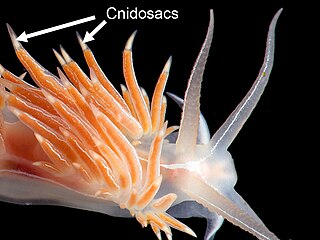
Cerata, singular ceras, are anatomical structures found externally in nudibranch sea slugs, especially in aeolid nudibranchs, marine opisthobranch gastropod mollusks in the clade Aeolidida. The word ceras comes from the Greek word "κέρας", meaning "horn", a reference to the shape of these structures.

Aeolidia papillosa, known as the common grey sea slug, is a species of nudibranch in the family Aeolidiidae.

The purple lady nudibranch, Paraflabellina funeka, is a species of aeolid nudibranch, and is a very colourful sea slug. It is a marine gastropod mollusc in the family Flabellinidae.

The white-edged nudibranch, Fjordia capensis, is a species of sea slug, specifically an aeolid nudibranch, a very colourful sea slug. It is a marine gastropod mollusc in the family Flabellinidae.

Trinchesia speciosa, common name the "candy nudibranch", is a species of sea slug, an aeolid nudibranch, a marine gastropod mollusc in the family Trinchesiidae.
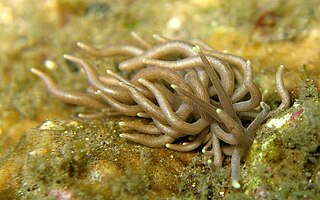
Phyllodesmium is a genus of predatory sea slugs, aeolid nudibranchs, marine gastropod molluscs in the family Facelinidae.
The black-dot nudibranch, Caloria sp. 1, as designated by Gosliner, 1987, is a species of sea slug, specifically an aeolid nudibranch. They are marine gastropod molluscs in the family Facelinidae.
The yellow-tipped nudibranch, Caloria sp. 2, as designated by Gosliner, 1987, is a species of sea slug, specifically an aeolid nudibranch, a marine gastropod mollusc in the family Facelinidae.

Pteraeolidia ianthina is a sea slug, an aeolid nudibranch in the family Facelinidae. It is known as a blue dragon, a name it shares with Glaucus atlanticus and Glaucus marginatus.

Berghia is a genus of sea slugs, aeolid nudibranchs. They are shell-less marine gastropod molluscs in the family Aeolidiidae. They are covered in cerata which give them their unique tentacle look and color. Berghia are commonly found in shallow waters and their diet consists of strictly Aiptasia Anemone. This genus is now commonly used commercially to fight off Anemone populations in fish tanks.
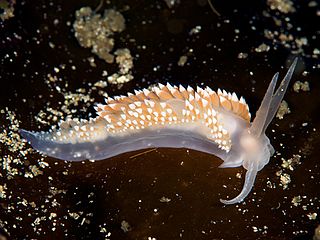
Coryphella verrucosa, is a species of sea slug, an aeolid nudibranch, a marine gastropod mollusc in the family Coryphellidae.
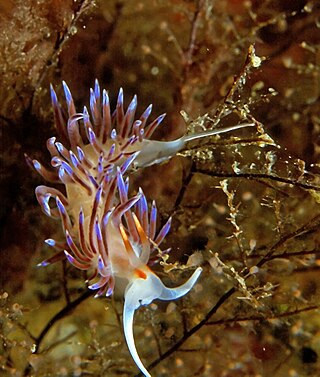
Cratena peregrina, commonly called the pilgrim hervia, is a species of sea slug, an aeolid nudibranch, a marine gastropod mollusc in the family Facelinidae.

A cnidosac is an anatomical feature that is found in the group of sea slugs known as aeolid nudibranchs, a clade of marine opisthobranch gastropod molluscs. A cnidosac contains cnidocytes, stinging cells that are also known as cnidoblasts or nematocysts. These stinging cells are not made by the nudibranch, but by the species that it feeds upon. However, once the nudibranch is armed with these stinging cells, they are used in its own defense.

Tenellia phoenix is a species of sea slug, an aeolid nudibranch, a marine gastropod mollusc in the family Fionidae.

Spurilla neapolitana, the Neapolitan spurilla, is a species of sea slug, an aeolid nudibranch, a marine gastropod mollusk in the family Aeolidiidae. It is native to the western Atlantic Ocean, the Caribbean Sea and the Mediterranean Sea. This species was first described as Eolis neapolitana by the Italian naturalist Stefano delle Chiaje in 1841. However, although some authorities quote the year as 1823, the species does not appear in the first volume of delle Chiaje's memoirs, which was published that year. The species was later reassigned to the genus Spurilla.
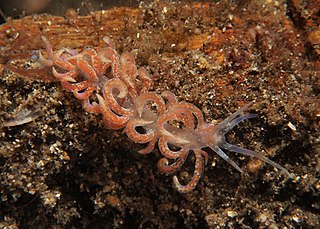
Phyllodesmium poindimiei is an Alcyonacea feeding, aeolid nudibranch Gastropod belonging to the family Facelinidae. Cerata are important in this clade in terms of their physical defense and efficient metabolic processes. This species is spread sporadically along tropical coastal regions such as Australia, Hawaii, and the Indo-Pacific living in diverse marine habitats such as coral reefs. Unlike other species in the Opisthobranch Mollusca clade, P. poindimiei’s lush pink cerata are used for defensive purposes other than Nematocyst (dinoflagellate) capture and toxin release. Organismal ties within these thriving, tropical ecosystems can be determinants of environment change, which affects massive coral ecosystems. Continuously changing marine ecosystems, such as coral reefs, are directly linked to the evolution of organisms that live and thrive in the tropics such as the soft nudibrach P. poindimiei.
















